Voice Conversion 專案筆記(含從VCC 2016匿名比賽深挖的各前沿方法效能對比)
阿新 • • 發佈:2019-01-02
voice conversion 基本架構:
voice conversion 任務主要由兩個步驟構成,特徵提取與特徵引數轉換,對於這兩個步驟,都有相應的常用的技術,這兩個步驟中常用的技術各種排列組合,就產生了眾多VC系統,以下做小彙總。
其中,LF0為語音基頻log變換,為主要的語音轉換引數,是表徵不同人,不同性別的最重要引數之一。
其他引數為語音的高階分量,控制合成語音的細節。
衡量標準:
常用的兩種:基於主觀評分的MOS和基於Mel譜失真的MCD
MOS(Mean Opinion Score) 主觀評分 分值1-5 由受試者主觀打分 一般有GMM方法的MOS分作為beseline,對於不同的測試可以考慮把GMM的分數對齊從而在不同的MOS測試中統一基準
打分基準:
4-5分 優秀(excelent) 很好,聽的清楚,延遲很小,交流流暢
3-4分 良好(good) 稍差,聽的清楚,延遲小,交流欠缺順暢,有點雜音
2-3分 一般(fair) 還可以,聽不太清,有一定延遲,可以交流
1-2分 差(poor) 勉強,聽不太清,延遲較大,交流重複多次1分以下 很差(bad) 極差,聽不懂,延遲大,交流不通暢
MCD(Mel-cepstral distortion)[dB] 越低越好
例:
seq2seq with LSTM:

Variational Auto-encoder:
Deep sequence-to-sequence Attention Model :
VCC2016: 各組綜合分數對比: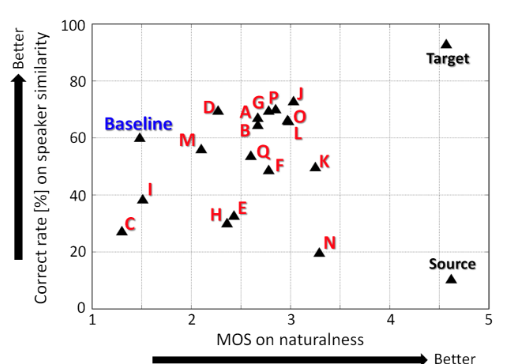
各組方案對比(紅圈為MOS>2.5 similarity>60%的方案,紫色橫線表示不會公開方法的組別)
其中G,L,O 組 很多都採用了STRAIGHT工具包進行MGC特徵的提取 轉換方法上,常採用GMM或者LSTM方法 開源的組轉換結果樣例: 效果較好的: 略遜的: 各組的報告,包括使用的引數,工具包,及其方法: 各組來源:
現在可用的轉換方法: 用不同的神經網路對不同引數進行轉換 用AHOcoder進行特徵提取: LF0:LSTM MVF:DNN MCP:GRU 轉換結果樣例:(基於VCC2016 資料) 基於LSF LF0 UV的方法: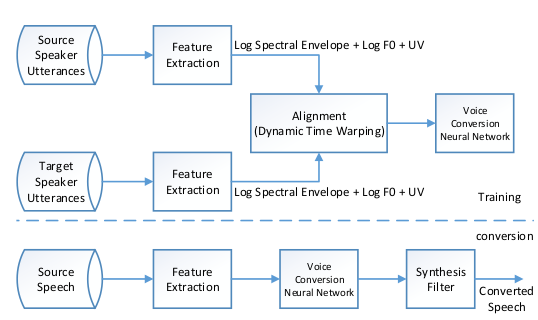
轉換結果樣例: 還在下載 基於GMM的轉換: 利用SPTK提取MCEP引數,對MCEP引數用24階GMM進行轉換: 轉換結果樣例: 各機構的Demo: Voice Conversion 方法,連結如下: TTS方法,連結如下: 建議: 在VCC2016比賽中,效果較好的組在語音特徵提取的環節都採用了STRAIGHT工具包,應對此進行進一步的探索 未開源及展示論文的方案可能由於經過cherry-picked的調參,復現可能有一定困難 開源的方案主要是都以LSTM作為主要模型,用於轉換LF0,MCEP等特徵 現有的轉換方法中,以基於GMM的MCEP特徵轉換作為基準,利用LSTM轉換LF0的這種方法效能較好,其MOS評分應在2-3分左右,普解析度較低 可以用STRAIGHT替換AHOcoder進行特徵提取,並使用LSTM進行LF0和MCEP的轉換(嘗試研究G組的方案)。 參考論文及其效能展示: 常用傳統轉換技術對比(不包括各類神經網路方法):
IEEE(只看了一下,包括其中G組的方案): Voice conversion using deep neural networks with speaker-independent pre-training Dictionary update for NMF-based voice conversion using an encoder-decoder network Text-independent voice conversion using deep neural network based phonetic level features F0 transformation techniques for statistical voice conversion with direct waveform modification with spectral differential Enhancing a glossectomy patient's speech via GMM-based voice conversion Deep neural network based voice conversion with a large synthesized parallel corpus SEQ2SEQ類: Voice Conversion Using Sequence-to-Sequence Learning of Context Posterior Probabilities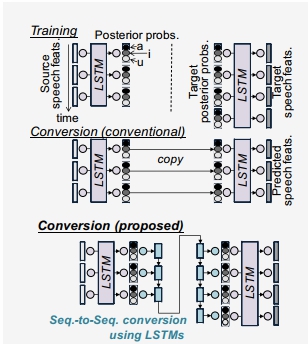

Voice Conversion from Unaligned Corpora using Variational Autoencoding Wasserstein Generative Adversarial Networks
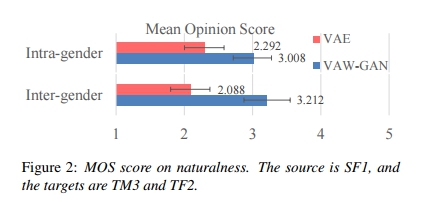
VAE: Voice Conversion from Non-parallel Corpora Using Variational Auto-encoder
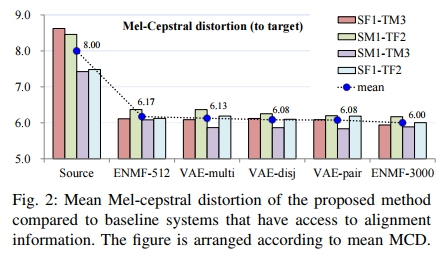
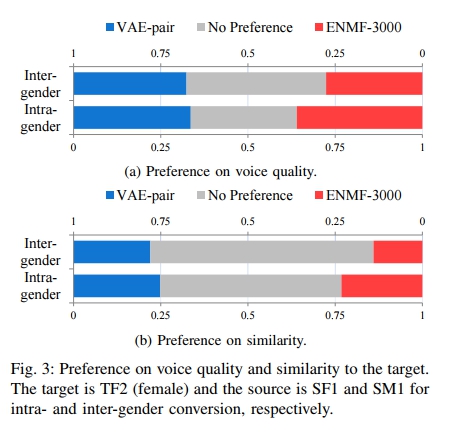
DNN:



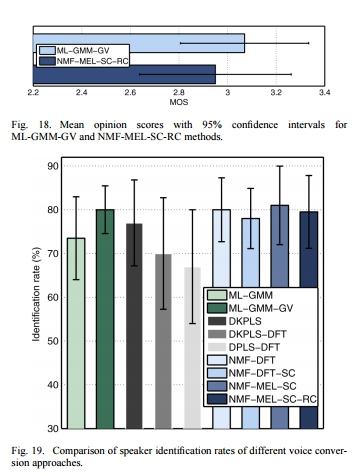

4 Proposed Framework: Deep sequence-to-sequence Attention Model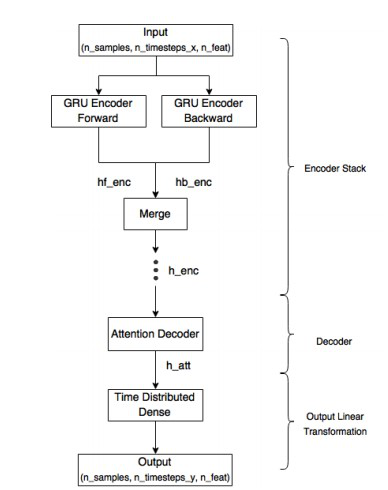


尋找對應組: I組:NII National Institute of Informatics: NON-PARALLEL VOICE CONVERSION USING I-VECTOR PLDA: TOWARDS UNIFYING SPEAKER VERIFICATION AND TRANSFORMATION

L組:西北工業大學,謝磊: An Automatic Voice Conversion Evaluation Strategy Based on Perceptual Background Noise Distortion and Speaker Similarity

J組:NU-NAIST: F0 transformation techniques for statistical voice conversion with direct waveform modification with spectral differential C組:UTSC-NELLSILP:(jun du) 未知:University College London voice conversion challenge: Hulk組【G組】:Phone-aware LSTM-RNN for voice conversion B組:Zhizheng WU: CSTR The Centre for Speech Technology Research, The University of Edinburgh, UK F組:HCCL-CUHK Human-Computer Communications Laboratory The Chinese University of Hong Kong, Hong Kong 日本人的復現: 【一個用DNN的組(O(也有可能是C))】VoiceKontrol Center for Spoken Language Understanding (CSLU), Oregon Health & Science University, Portland, OR, USA S.H. Mohammadi, A. Kain, Semi-supervised Training of a Voice Conversion Mapping Function using Joint-Autoencoder, Interspeech (To Appear), 2015. S.H. Mohammadi, A. Kain, Voice Conversion Using Deep Neural Networks With Speaker-Independent Pre-Training, 2014 IEEE Spoken Language Technology Workshop (SLT), 2014. 復現: 還沒找到的: 1. CASIA-NLPR-Taogroup National Laboratory of Pattern Recognition, Institute of Automation, Chinese Academy of Sciences, Beijing, China 2. Team Initiator Tsinghua University, Beijing, China 3. AST Academia Sinica, Taipei, Taiwan github: RNN: LSTM:(還不錯)(F組) Pitchlinear conversion: 相位加速: DNN+mfcc(C/O組) STRAIGHT,F0,GMM GMM VAE: 5月18日更新: LyreBird的在ICLR 2017上的論文: SAMPLERNN: AN UNCONDITIONAL END-TO-END NEURAL AUDIO GENERATION MODEL
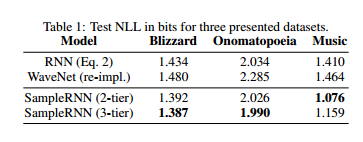
法語語音轉換公司CandyVoice: 基於發聲系統建模的發聲系統建模器festvox:flite Flite 1.先用相同性別/年齡段的TTS進行發音 2.基於CUTE技術進行波形擬合和編輯——跟adobe VOCO師出同源 這就是VOCO,都是Zeyu Jin的東西
| STEP1:Feature extraction | STEP2:Feature conversion | ||
| Feature | Extraction toolkits | description | |
| LSF(Line Spectral Frequency) | STRAIGHT | STRAIGHT is an MATLAB Lib design for VC. | GMM/JDGMM |
|
MGC(mel-generalized coeffi- cient ) |
STRAIGHT | DNN | |
| LF0(log f0) | AHOCODER | Ahocoder parameterizes speech waveforms into three different streams | RNN(BLSTM) |
| MCP(mel-spectgram) | AHOCODER | seq2seq/(with Attention) | |
| MVF(maximum voiced frequency) | AHOCODER | GRU | |
| DBN | VQ | ||
| Mixture of Factor Analyzer | |||
| parameter generation algorithm with global variance | HTS | HMM-based Speech Synthesis System |

Variational Auto-encoder:

Deep sequence-to-sequence Attention Model :

VCC2016: 各組綜合分數對比:

各組方案對比(紅圈為MOS>2.5 similarity>60%的方案,紫色橫線表示不會公開方法的組別)

其中G,L,O 組 很多都採用了STRAIGHT工具包進行MGC特徵的提取 轉換方法上,常採用GMM或者LSTM方法 開源的組轉換結果樣例: 效果較好的: 略遜的: 各組的報告,包括使用的引數,工具包,及其方法: 各組來源:

現在可用的轉換方法: 用不同的神經網路對不同引數進行轉換 用AHOcoder進行特徵提取: LF0:LSTM MVF:DNN MCP:GRU 轉換結果樣例:(基於VCC2016 資料) 基於LSF LF0 UV的方法:

轉換結果樣例: 還在下載 基於GMM的轉換: 利用SPTK提取MCEP引數,對MCEP引數用24階GMM進行轉換: 轉換結果樣例: 各機構的Demo: Voice Conversion 方法,連結如下: TTS方法,連結如下: 建議: 在VCC2016比賽中,效果較好的組在語音特徵提取的環節都採用了STRAIGHT工具包,應對此進行進一步的探索 未開源及展示論文的方案可能由於經過cherry-picked的調參,復現可能有一定困難 開源的方案主要是都以LSTM作為主要模型,用於轉換LF0,MCEP等特徵 現有的轉換方法中,以基於GMM的MCEP特徵轉換作為基準,利用LSTM轉換LF0的這種方法效能較好,其MOS評分應在2-3分左右,普解析度較低 可以用STRAIGHT替換AHOcoder進行特徵提取,並使用LSTM進行LF0和MCEP的轉換(嘗試研究G組的方案)。 參考論文及其效能展示: 常用傳統轉換技術對比(不包括各類神經網路方法):

IEEE(只看了一下,包括其中G組的方案): Voice conversion using deep neural networks with speaker-independent pre-training Dictionary update for NMF-based voice conversion using an encoder-decoder network Text-independent voice conversion using deep neural network based phonetic level features F0 transformation techniques for statistical voice conversion with direct waveform modification with spectral differential Enhancing a glossectomy patient's speech via GMM-based voice conversion Deep neural network based voice conversion with a large synthesized parallel corpus SEQ2SEQ類: Voice Conversion Using Sequence-to-Sequence Learning of Context Posterior Probabilities


Voice Conversion from Unaligned Corpora using Variational Autoencoding Wasserstein Generative Adversarial Networks


VAE: Voice Conversion from Non-parallel Corpora Using Variational Auto-encoder



DNN:






4 Proposed Framework: Deep sequence-to-sequence Attention Model



尋找對應組: I組:NII National Institute of Informatics: NON-PARALLEL VOICE CONVERSION USING I-VECTOR PLDA: TOWARDS UNIFYING SPEAKER VERIFICATION AND TRANSFORMATION


L組:西北工業大學,謝磊: An Automatic Voice Conversion Evaluation Strategy Based on Perceptual Background Noise Distortion and Speaker Similarity


J組:NU-NAIST: F0 transformation techniques for statistical voice conversion with direct waveform modification with spectral differential C組:UTSC-NELLSILP:(jun du) 未知:University College London voice conversion challenge: Hulk組【G組】:Phone-aware LSTM-RNN for voice conversion B組:Zhizheng WU: CSTR The Centre for Speech Technology Research, The University of Edinburgh, UK F組:HCCL-CUHK Human-Computer Communications Laboratory The Chinese University of Hong Kong, Hong Kong 日本人的復現: 【一個用DNN的組(O(也有可能是C))】VoiceKontrol Center for Spoken Language Understanding (CSLU), Oregon Health & Science University, Portland, OR, USA S.H. Mohammadi, A. Kain, Semi-supervised Training of a Voice Conversion Mapping Function using Joint-Autoencoder, Interspeech (To Appear), 2015. S.H. Mohammadi, A. Kain, Voice Conversion Using Deep Neural Networks With Speaker-Independent Pre-Training, 2014 IEEE Spoken Language Technology Workshop (SLT), 2014. 復現: 還沒找到的: 1. CASIA-NLPR-Taogroup National Laboratory of Pattern Recognition, Institute of Automation, Chinese Academy of Sciences, Beijing, China 2. Team Initiator Tsinghua University, Beijing, China 3. AST Academia Sinica, Taipei, Taiwan github: RNN: LSTM:(還不錯)(F組) Pitchlinear conversion: 相位加速: DNN+mfcc(C/O組) STRAIGHT,F0,GMM GMM VAE: 5月18日更新: LyreBird的在ICLR 2017上的論文: SAMPLERNN: AN UNCONDITIONAL END-TO-END NEURAL AUDIO GENERATION MODEL


法語語音轉換公司CandyVoice: 基於發聲系統建模的發聲系統建模器festvox:flite Flite 1.先用相同性別/年齡段的TTS進行發音 2.基於CUTE技術進行波形擬合和編輯——跟adobe VOCO師出同源 這就是VOCO,都是Zeyu Jin的東西
